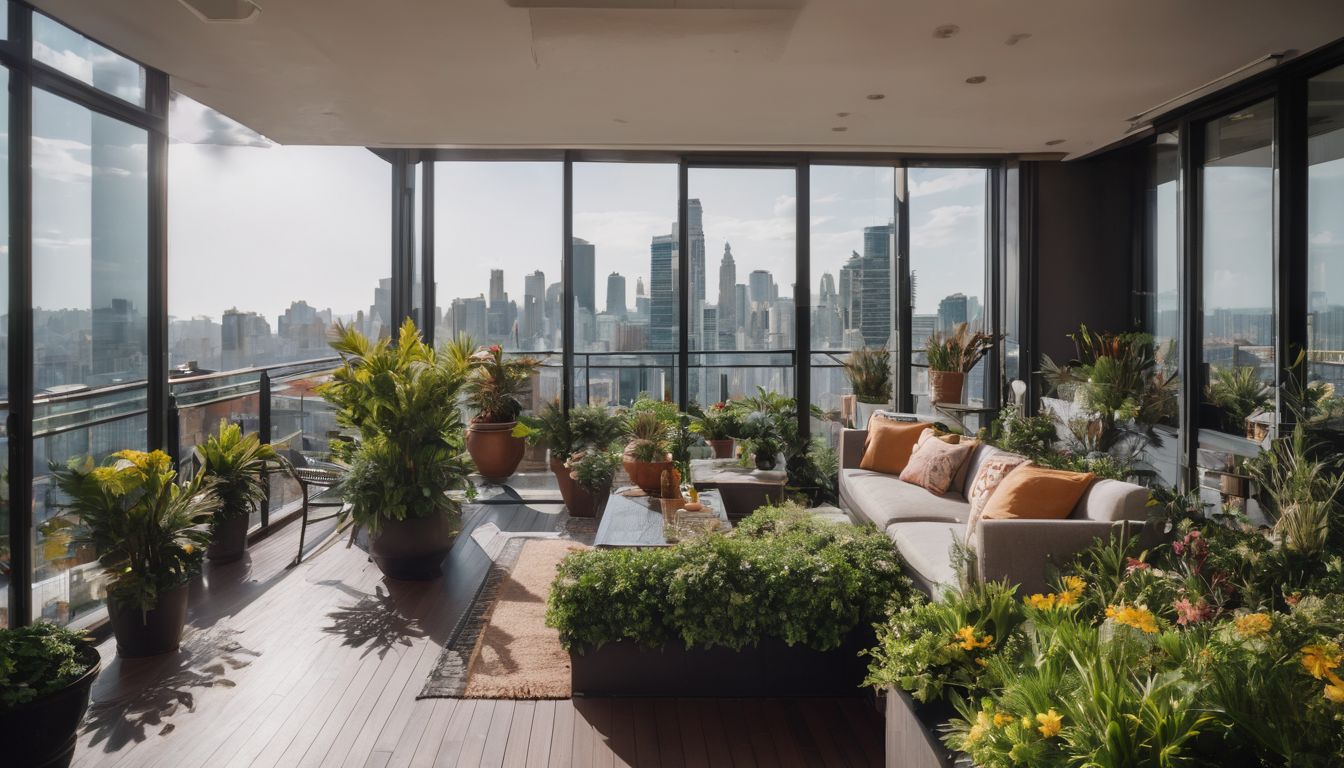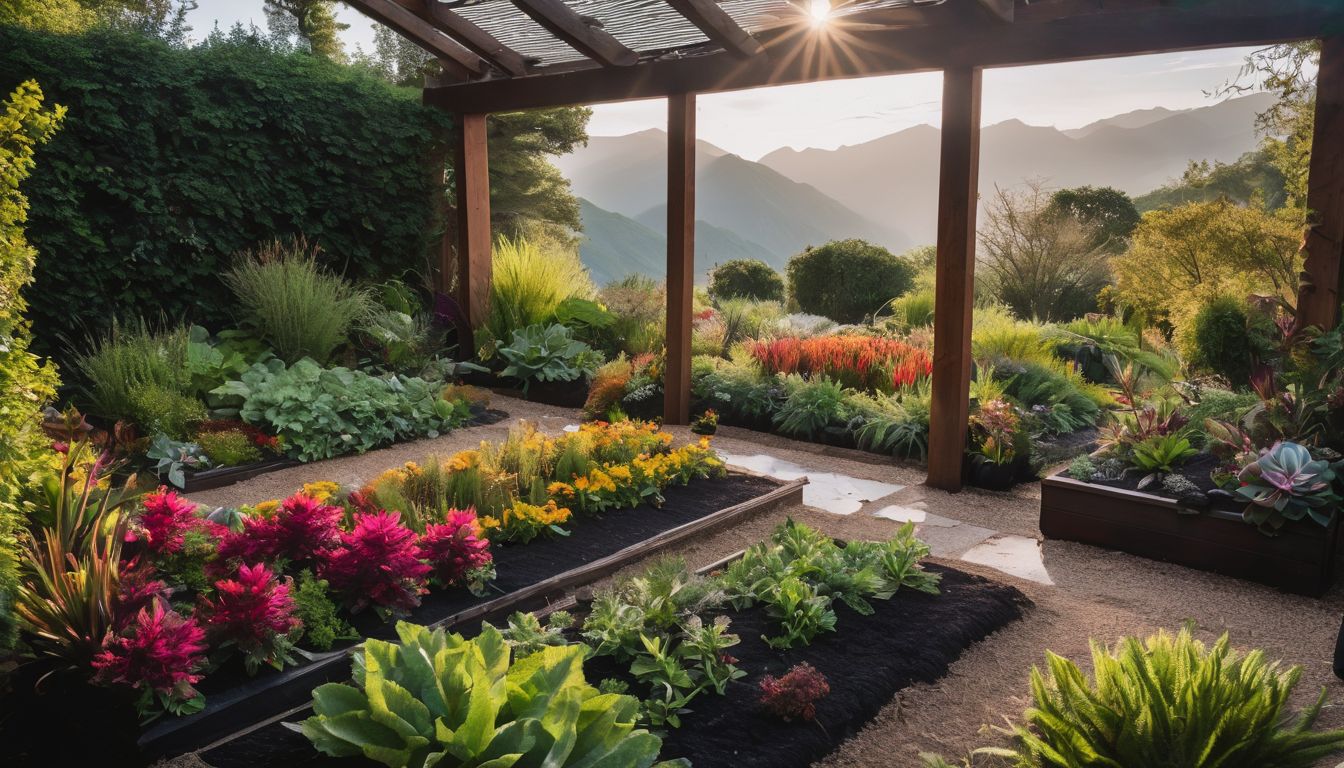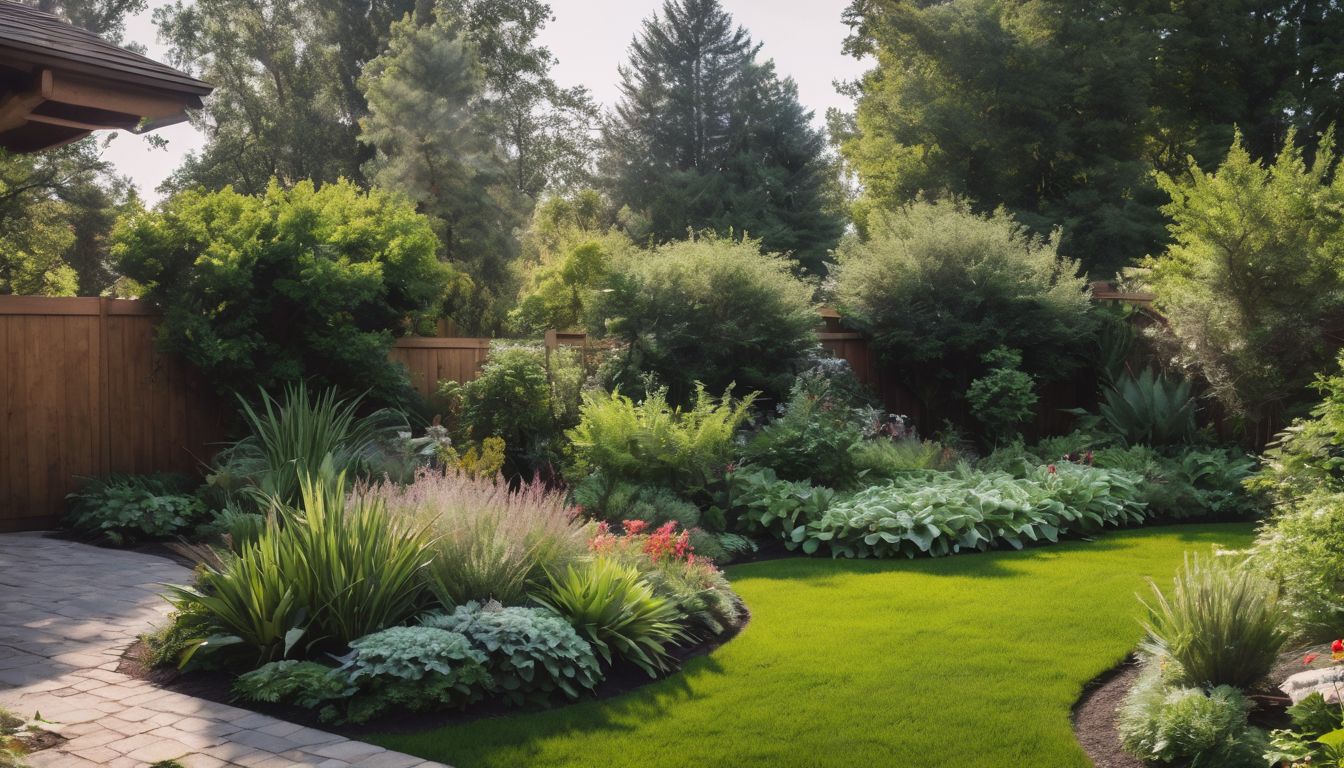Are your flowers blooming but still no buzzing bees in sight? Pollinators, especially bees, are crucial for a thriving garden as they’re responsible for nearly 80% of all flower and crop pollination.
This article provides easy and practical tips to transform your space into a haven for these vital creatures. Dive in to make a difference!
Key Takeaways
- Native plants are vital in a bee – friendly garden as they provide essential nectar, pollen, and habitat for local pollinators.
- Diverse flower varieties including lavender, chives, and black – eyed Susans attract different species of bees and support ecosystem health.
- Avoiding insecticides protects pollinators from harm while natural pest control methods help maintain a safe environment for them.
- Providing shelters such as bee boxes and water sources like shallow dishes ensures bees have suitable habitats for nesting and hydration.
- To sustain pollinator populations throughout the year, include plants that bloom at various times and consider setting up sugar water traps to supplement their nectar intake.
Why Attract Pollinators to Your Garden?
Attracting pollinators to your garden is crucial for increasing pollination, improving crop yield, and supporting the local ecosystem. By creating a bee-friendly environment, you can help sustain the population of bees and other essential pollinators.
Increase pollination
Boosting pollination in your garden is a sure-fire way to encourage plants to thrive. Honeybees, butterflies, and other beneficial insects transfer pollen from one flower to another, which is crucial for plant reproduction.
By enhancing the conditions for these creatures, you’re not only aiding their survival but also improving the health and diversity of your flora.
A richly diverse garden brimming with native nectar sources offers pollinators a bountiful feast that can ultimately lead to an increased yield of fruits and vegetables. Cultivating such an environment promotes biodiversity and sustains the delicate balance of our local ecosystems.
Next up: how precisely can you transform your green space into a sanctuary for bees and their fellow pollinators?.
Improve crop yield
Boosting crop yield is a crucial benefit of attracting pollinators to your garden. Bees and other pollinating insects play a vital role in the reproduction of many plants, including fruits, vegetables, and flowers.
By ensuring that these beneficial insects have a thriving habitat in your garden, you can significantly increase the quantity and quality of your harvests. The enhanced pollination results in larger and more abundant crops, contributing to food security while also supporting the local ecosystem.
Enhancing crop yield through pollinator attraction not only benefits individual gardeners but also has broader implications for sustainable agriculture and conservation efforts. When honey bees are attracted to an area and thrive due to suitable habitats, their population supports plant biodiversity which positively impacts overall wildlife and habitat preservation.
Support local ecosystem
By creating a bee-friendly garden and attracting pollinators, you can support the local ecosystem. Planting native flowers and providing nesting habitats not only benefits bees but also provides essential food sources for other local wildlife.
Supporting the local ecosystem through bee-friendly practices helps maintain biodiversity and ensures a healthy environment for all living organisms.
Now let’s explore the top 10 plants to attract bees in your garden.
How to Create a Bee-Friendly Garden
Choose native plants that are well-suited to your region’s climate, provide a variety of flowers to attract different species of bees, limit the use of insecticides, create nesting habitats such as bare patches of soil or wood piles, and provide shelter and water sources for pollinators.
Choose native plants
Selecting native plants for your garden is crucial in attracting pollinators. Native plants have co-evolved with local pollinators, providing the right nectar, pollen, and habitat for them.
By choosing native plants such as lavender, chives, and black-eyed Susans, you’ll help sustain the natural ecosystem while providing food sources for bees. These plants are adapted to local climate and soil conditions, requiring less maintenance and water once established.
Opting for native flora also enhances biodiversity by supporting a wide range of insects and other wildlife. This helps maintain a healthy ecological balance while preserving the unique characteristics of your local environment.
Provide a variety of flowers
Selecting a variety of flowers is crucial for attracting and supporting different pollinators in your garden. Planting a diverse range of native flowers provides an essential food source for bees, butterflies, and other beneficial insects throughout the growing season.
When choosing plants, consider selecting a mix of flower shapes, sizes, and colours to cater to various pollinator species. This diversity will ensure that your garden remains attractive to a wide array of pollinators, contributing to the overall health and biodiversity of your local ecosystem.
When creating a bee-friendly garden, it’s essential to include early- and late-blooming flowers alongside those that bloom during peak summer months. By doing so, you’ll sustainably support pollinators throughout the year while also adding vibrant bursts of colour to your outdoor space.
Additionally, planting flowers in clusters or groupings can make them more visible and accessible to visiting pollinators.
Limit use of insecticides
To create a bee-friendly garden, it is important to limit the use of insecticides. Chemical insecticides can harm pollinators like bees and other beneficial insects. Instead, consider using natural pest control methods or organic alternatives to protect your plants while supporting a healthy ecosystem.
By reducing the use of insecticides in your garden, you can create a safer environment for pollinators and contribute to the conservation of these essential creatures.
Now let’s move on to the next step – “Create nesting habitats”.
Provide shelter and water sources
To attract pollinators like bees to your garden, it’s essential to provide shelter and water sources. You can create shelter by leaving some areas of your garden untended, allowing for natural habitats such as logs or piles of leaves where bees can find refuge.
In addition, providing shallow dishes with water or creating a simple bee bath with rocks for the insects to land on will help supply them with the hydration they need.
Creating an inviting environment that offers necessary resources is crucial in supporting the conservation of bees and other pollinators. By ensuring there are suitable shelters and accessible sources of water in your garden, you can play a vital role in nurturing these essential contributors to our ecosystem.
Top 10 Plants to Attract Bees
Lavender, sunflowers, chives, coneflowers and black-eyed susans are just a few of the top 10 plants that will attract bees to your garden. These flowers provide nectar and pollen for the bees to feed on, helping to support their populations.
Chives
Transitioning from vibrant, pollen-rich sunflowers, chives offer a delicate source of nectar for bees, while also repelling unwanted pests. These hardy perennial herbs produce beautiful purple flowers that not only attract pollinators but also add aesthetic value to your garden.
Planting chives alongside other flowering plants can enhance the biodiversity of your bee-friendly garden and contribute to a healthy ecosystem.
Chives contain essential oils that act as natural insect repellents, making them an excellent addition to any garden aiming to support bee populations. Additionally, their ability to thrive in various conditions makes them an ideal plant for both novice and seasoned gardeners looking to create a sustainable environment for pollinators.
Coneflowers
Transitioning from chives, another fantastic addition to your bee-friendly garden is coneflowers. These beautiful, daisy-like flowers with prominent raised centers not only add splashes of color to your garden but also attract bees and butterflies.
Coneflowers are easy to grow and come in a variety of colors, including purple, pink, white, and orange. Their nectar-rich blooms provide an abundant food source for pollinators throughout the summer months.
Coneflowers can be planted in clusters or mixed with other perennials to create a vibrant and inviting environment for bees. Their sturdy stems make them perfect for cutting gardens too.
Black-eyed Susans
Black-eyed Susans are vibrant, yellow flowers that attract bees with their nectar and pollen. These native plants are easy to grow and maintain, making them a perfect addition to any bee-friendly garden.
Black-eyed Susans bloom throughout the summer, providing a long-lasting food source for pollinators while adding a burst of color to your outdoor space.
Planting Black-eyed Susans in clusters will create an attractive feeding ground for bees and other pollinators. Their daisy-like blooms offer abundant opportunities for insects to collect pollen, supporting the local ecosystem and contributing to increased pollination rates.
Salvia
Salvia, also known as sage, is a great addition to any bee-friendly garden. Its aromatic foliage and colorful flowers attract pollinators such as bees and butterflies. Salvia comes in various species and cultivars, providing a wide range of options to choose from.
Planting different types of salvia can help create a diverse and attractive environment for pollinators.
The vibrant blooms of salvia produce nectar that serves as an essential food source for bees throughout the flowering season. These plants are resilient and low-maintenance, making them perfect for gardeners looking to support their local ecosystem without much effort.
Cosmos
Cosmos is a lovely addition to any bee-friendly garden. Their vibrant, daisy-like flowers are not only beautiful to look at but also attract bees and other pollinators with their abundant nectar.
Planting cosmos in your garden provides an excellent food source for bees and helps support the local ecosystem by encouraging pollination. These low-maintenance plants thrive in sunny locations and well-drained soil, making them a perfect choice for environmentally conscious individuals looking to create a welcoming habitat for bees while adding visual appeal to their gardens.
Creating a bee-friendly environment with cosmos and other pollinator-attracting plants contributes to the conservation of these vital creatures and promotes a healthy balance within the ecosystem.
Bee Balm
Moving on to another fantastic plant for attracting bees, Bee Balm is a must-have in your bee-friendly garden. Its vibrant and nectar-rich flowers are irresistible to bees, hummingbirds, and butterflies alike.
Bee Balm comes in various colors such as red, pink, and purple, making it an eye-catching addition to any garden. This flowering herb also has aromatic foliage that emits a lovely scent when brushed against or crushed.
Bees are particularly drawn to the sweet fragrance of Bee Balm flowers, making it an excellent choice for supporting pollinators in your local ecosystem.
Marigolds
Marigolds are a vibrant and low-maintenance option for attracting pollinators to your garden. Their bright, yellow and orange blooms make them a favorite among bees and butterflies, adding a burst of color while also fulfilling their role as valuable pollinators.
Marigolds thrive in full sunlight and well-drained soil, making them an easy addition to any bee-friendly garden. Their aromatic foliage also acts as a natural pest deterrent, further supporting the health of your local ecosystem.
When planting marigolds in your garden, opt for open-pollinated varieties to provide nectar and pollen for bees throughout the growing season. Incorporating these cheerful flowers into your landscape not only adds aesthetic appeal but also actively contributes to sustaining precious bee populations while fostering biodiversity in your environment.
Hyacinths
Hyacinths are vibrant, fragrant flowers that can attract pollinators to your garden. They produce an abundance of nectar and pollen, making them a valuable food source for bees. Planting hyacinths in your bee-friendly garden not only adds beauty but also provides essential sustenance for pollinators.
These showy blooms come in a variety of colors and will help create a visually stunning and inviting environment for bees.
Moreover, the structure of hyacinth flowers makes it easy for bees to access their nectar and pollen, attracting these beneficial insects to your garden. By including hyacinths in your garden, you can contribute to the conservation of bees while enjoying the delightful sight and scent they bring to your outdoor space.
Other Ways to Attract Pollinators
In addition to planting bee-friendly flowers, consider installing bee boxes to provide nesting sites for solitary bees. Another way to attract pollinators is by using sugar water traps to supplement their nectar needs and create a pollinator-friendly environment by limiting the use of chemical pesticides.
Install bee boxes
Install bee boxes in your garden to provide nesting habitats for solitary bees. Place the boxes in a sunny spot, facing south or east, and at least three feet off the ground. Ensure that the openings are not obstructed by vegetation and protect them from strong winds.
Each box should have different-sized holes to accommodate various species of solitary bees, offering them a safe place to lay eggs and raise their young.
These simple structures can help support declining bee populations and enhance pollination in your garden. By installing bee boxes, you create an inviting environment for these essential pollinators while contributing to the preservation of local ecosystems.
Use sugar water traps
Entice pollinators like bees and butterflies into your garden by using sugar water traps. Mix a solution of equal parts sugar and water, then soak a small sponge or cloth in the mixture.
Hang these traps near flowering plants to attract and nourish these beneficial insects. This simple method provides ample energy for them and encourages them to linger, aiding in effective pollination.
Create a pollinator-friendly environment
To create a pollinator-friendly environment, plant a variety of native flowers in your garden. Include a mix of colours and shapes to attract different types of bees and other pollinators.
Minimise the use of insecticides to keep the area safe for these essential creatures. Designate some spaces for nesting habitats and provide shelter, such as shrubs or tall grasses, along with water sources like birdbaths to meet their needs.
Encourage biodiversity by planting an array of flowers that bloom at different times throughout the year. This will entice various species of pollinators to visit your garden regularly, supporting their population and ensuring successful pollination across seasons.
Conclusion
In conclusion, creating a bee-friendly garden benefits the environment. By choosing native plants and limiting insecticide use, you can attract more pollinators. Providing nesting habitats and water sources further supports the local ecosystem.
With these steps, your garden will thrive while supporting conservation efforts for bees and other pollinators.
FAQs
1. Why is creating a bee-friendly garden important?
Creating a bee-friendly garden helps attract pollinators, vital for plant reproduction and maintaining healthy ecosystems.
2. What plants should I include in a bee-friendly garden?
Include diverse flowering plants that bloom throughout the seasons to provide continuous food sources for bees.
3. Can having a beehive improve my garden’s health?
Yes, beekeeping can boost your garden’s productivity by increasing pollination and thus ensuring more flowers and fruits are produced.
4. How else can I make my garden welcoming to bees?
Offer clean water sources, avoid using harmful pesticides, and leave some natural habitat areas like bare soil or dead wood for nesting.





